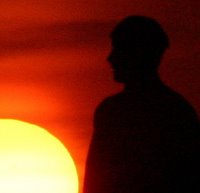
Six am. Sun up time on Koh Sdach, an island off the barren beaches of Koh Kong province, Cambodia. I’m sitting on a red plastic stool in the Vietnamese family’s cafe by the ferry port, eating a bowl of steaming rice noodles and pork liver, writing for as long as my laptop battery will last. Lately, it’s been giving out around the ten minute mark.
Scraggly young chickens scramble energetically for scraps on the wooden plank floor. They and the dogs are the only ones fully awake and alert at this hour. The villagers are still blinking away their sleep, rising from hammocks to the smell of grilled sesame waffles and thick coffee. Mr. Sok is already playing videos in his karaoke shop, but at least the volume is down.
This is my second trip to Koh Sdach, where the fast boat between Sihanoukville and the Thai border town of Koh Kong makes a stop. The boat is popular with travelers; dozens ride it every day in high season, but only a few ever get off at the island halfway. Koh Sdach isn’t mentioned in the major guidebooks, so very few travelers know to make this detour. Even those who do know that the boat makes a stop are sometimes thwarted by Cambodians who have no interest in sending customers off the established tourist trail. Of the five agents I asked in Sihanoukville, two had not heard of Koh Sdach, one thought it was in Thailand and two claimed that I would need to pay full fare ($15) to get off halfway. I finally just went to the port and bought the damn ticket myself for $10, although the ‘real’ price is only $8.
The island hasn’t changed much in the year I’ve been gone. A Swiss couple scouting locations for a guesthouse are in the room next door, but the penniless Irishman and his calculating Vietnamese wife have disappeared. Teams of men are building a concrete walkway and some new bungalows with indoor toilets down by the water, next to a restaurant that now boasts an English menu. The beaches on the mainland are still empty. No one goes to the surrounding islands apart from a few fishermen, who complain that there are fewer fish to catch and gasoline prices are high.
Koh Sdach is actually the most bustling metropolis on the long stretch of coast between Sihanoukville and Koh Kong. The whole region is cut off from the rest of Cambodia by the wild jungle of the Cardamom Mountains. Isolated fishing villages bring in supplies on long-tail skiffs because there is still no reliable overland access from the coast to the interior. The trickle of travelers who make it to Koh Sdach is a torrent compared to the utter seclusion of most beaches and islands in the region.

The forgotten Cambodian coast won’t stay quiet forever. Tracks hacked from the jungle will become logging roads, which will be widened and smoothed and eventually paved. Boatloads of curious young Westerners pass by the islands every day, and some have binoculars. People with money are starting to explore investments in tourist infrastructure. There are very few landmines in the region.
A Russian ‘businessman’ has already bought an island for himself near Sihanoukville, with plans to construct an entertainment palace. Unlike the Irishman and his wife, the Swiss couple seem likely to follow through on their dreams of island bungalows. A Frenchman with a boat is leasing beachfront huts on Koh Rong, the largest island between Koh Sdach and Sihanoukville.
Here is the paragraph from the Lonely Planet guide to Cambodia that first pointed me towards the Southwest coast.
Around Sihanoukville:
“Further afield are the large islands of Koh Rong and Koh Rong Samlon. Both are surrounded by blissfully empty, beautiful beaches and have freshwater sources, suggesting they will be a major focus for future development…If one place is set to become the Ko Samui (Thailand) of Cambodia, this is it – don’t worry though, it won’t be for at least another five years!”
The Lonely Planet does not mention Koh Sdach, but I would bet $100 that the next edition will.
From December 22nd until January 21st I will explore this lonely and beautiful place with Ryan Libre, a great photographer and an even better friend. Ryan will take photos, I’ll write, and together we’ll try to document what is here before it evolves and fades and becomes another place entirely. A trip, which we sometimes glorify by calling an Expedition…its boundaries a sea, a sky, a cycle of the moon, its limits - our own, without reservation.
My model for this month of exploration is the journey described by John Steinbeck and Ed Ricketts in “Log From the Sea of Cortez,” which I paraphrase above. Those interested in what exactly I’m trying for should find it at the library. In my humble opinion, The Log is the best travel book ever written.
I’ll be in Thailand until Ryan arrives and should be able to post frequently.
Labels: Cambodia, Koh Kong, Koh Sdach, Koh Sdech




